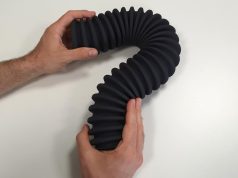Target reached for “Alba Cluster 3 & 4”, the recent new Alba Orbital’s space mission, that had a record breaking with 13 PocketQube satellites launched from SpaceX’s Falcon 9 rocket. The nanosatellites had been integrated in 5 Alba’s deployers, entirely 3D printed by CRP Technology in Windform XT 2.0 Carbon fiber filled composite material. The mission occurred on Thursday 13 January at 3.25pm (GMT) from Cape Canaveral, as part of SpaceX’s small satellite rideshare service and comprised a total of 105 small satellites
Five AlbaPod v2, the PocketQube deployers by Alba Orbital manufactured by CRP Technology using professional 3D printing and Carbon fiber reinforced composite material Windform XT 2.0, were launched into orbit as part of SpaceX’s Transporter-3 mission using Falcon 9 rocket, occurred on Thursday 13th January 2022.
The deployers successfully completed their mission: once had separated from Falcon 9, the deployers started launching into the orbit the PocketQubes, that in turn began to send signals to the earth.
With 13 PocketQube spacecrafts integrated into five 3D printed AlbaPods v.2 deployers, the mission represented Alba Orbital’s biggest cluster to date, and the first PocketQubes deployment from Falcon-9 Transporter-3. It has been the third dedicated launch for SpaceX’s small satellite rideshare service, which aims to give microsatellites and CubeSats a more affordable ride into orbit.
The Transporter -3 mission flew southeast from Cape Canaveral, then turned south to track parallel to Florida’s east coast to deliver the Falcon 9 rocket’s 105 satellite passengers into a roughly 326-mile-high (525-kilometer) polar sun-synchronous orbit.
Engineer Franco Cevolini, CEO and CTO at CRP Technology, states, “Congrats to Alba Orbital and to all the teams flown with them, for all their hard work. On Thursday 13th January 2022 it has been signed a new milestone in the nanosatellites arena: we are very proud of being part as supplier of materials and technology that are integration and space-proven! The successful mission demonstrates once again the extreme value of Windform for highly performance, heavy duty and mission-critical applications.
SpaceX’s Transporter-3 mission using Falcon 9 rocket and the related Alba Orbital’s “Alba Cluster 3 & 4” mission – that consisted in the integration of the 13 PocketQubes into 5 of the 3D printed deployers as preparation for the launch – represents not just a one-time prototype process, but an actual sector of work for both CRP Technology and the US-based partner CRP USA. CRP USA inaugurated this new era manufacturing the innovative TuPOD system launched by ISS years ago.”
Four out of the 13 PocketQubes that participated in the mission, marked a “first” :
“UNICORN-2A, 2D & 2E” are Alba Orbital’s first Earth Observation satellites designed to provide the highest resolution dataset of the earth at night;
1p “PION-BR1” is the very first satellite to be developed by a Brazilian start-up;
1p “GRIZU-263a” is Turkey’s first ever pico-satellite to be launched in-orbit, it was designed and built by Turkish student team Grizu-263 Uzay Takımı.
“TARTAN-ARTIBEUS -1” is the first intermittent, orbital edge computing nanosatellite that operates with no batteries aboard the SpaceX Falcon-9 Transporter-3 mission. This open source project was developed at Carnegie Mellon University
The other PocketQubes integrated in Alba’s 3D printed deployers were:
‘MDQube-SAT1’, an Argentinian 2p PocketQube developed by ‘classroom turned space start-up’ Innova Space, carrying out an IoT mission.
‘UNICORN-1′, another Alba built 2p PocketQube, designed in partnership with the European Space Agency – ESA.
“HADES’ & ‘EASAT”, twin 1.5p PocketQubes developed in Spain by AMSAT-EA and Hydra Space. They were designed for satellite communications between radio amateurs via a 145/435 MHz transponder.
‘SATTLA-2A & 2B’, open source project developed by Ariel University in Israel. These 2p PocketQubes will utilise WiFi cards for extreme long-range link applicable to transmit video for over 600km in LOS conditions.
‘DELFI-PQ’, a 3p PocketQube developed in the Netherlands by TU Delft | Aerospace Engineering. This satellite is a tech demo mission testing a LOFAR payload and a laser retro reflector.
crptechnology.com
windform.com
Subscribe to our Newsletter
3DPresso is a weekly newsletter that links to the most exciting global stories from the 3D printing and additive manufacturing industry.






















